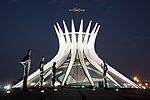Federal Institute of Brasília

The Federal Institute of Brasília (Portuguese: Instituto Federal de Brasília, IFB), or in full: Federal Institute of Education, Science and Technology of Brasília (Portuguese: Instituto Federal de Educação, Ciência e Tecnologia de Brasília) is an Institute of Technology located at the capital of Brazil that offers different types of degrees and operating often at variable levels of the educational system. It is an institution of Higher education and professional vocational education, specializing in science, engineering, and technology or different sorts of technical subjects. It is also a secondary education school focused on vocational training and applied Scientific research. IFB has the objective of forming ethical citizens and professionals and of being an institution involved with society. Its actions point toward the development of new technologies, cultural and social investments and the formation of critical citizens. The student's abilities are improved and testes through the courses, helping them to develop the "know-how", and values concerning all the areas.
Excerpt from the Wikipedia article Federal Institute of Brasília (License: CC BY-SA 3.0, Authors, Images).Federal Institute of Brasília
L2 Norte, Brasília Asa Norte
Geographical coordinates (GPS) Address Nearby Places Show on map
Geographical coordinates (GPS)
| Latitude | Longitude |
|---|---|
| N -15.7546 ° | E -47.8798 ° |
Address
L2 Norte
L2 Norte
70865-550 Brasília, Asa Norte
Federal District, Brazil
Open on Google Maps





